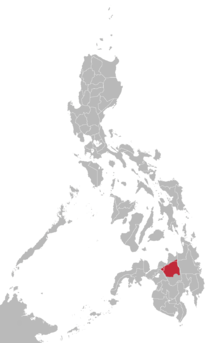Binukid language
| Bukid | |
|---|---|
| Binukid | |
| Native to | Philippines |
| Region | most parts of Bukidnon province, Mindanao |
|
Native speakers
|
(100,000 cited 1987) |
| Dialects |
|
| Language codes | |
| ISO 639-3 | |
| Glottolog | binu1244 |

Area where Binukid is spoken
|
|
The Bukid language, Binukid or Bukidnon, is an Austronesian language spoken by indigenous peoples of Northern Mindanao in southern Philippines. The word Bukid means "mountain" while Binukid means "in the manner, or style, of the mountain". It is a de facto co-official language in Bukidnon, where it is referred to as Higaonon. There are many dialects but there is mutual intelligibility. The dialect of Malaybalay, in the Pulangi area, is considered to be prestigious and standard.
Binukid is spoken in the following areas (Ethnologue).
Binukid consists of 20 segmental phonemes and 1 suprasegmental phoneme. The syllable is the basic unit of word structure, and each syllable consists of one vowel and one or two consonants only, arranged in the following patterns: CV, CVC and, in some instances, CCV (which is found mostly in Spanish loanwords). A word consists of one or more of these syllables.
There are 16 consonants in Binukid. In some instances, there is a voiceless alveolo-palatal affricate ⟨t͡ɕ⟩ which appears in Spanish loanwords.
The phoneme [ɾ] is sometimes trilled which is used in intervocalic position or in Spanish loanwords by some speakers. All consonants except [h] are found in initial and final position in the syllable; [h] is found only syllable-initial.
There are generally four vowels in Binukid.
There is a suprasegmental phoneme of stress which usually falls on the penultimate syllable. Stress give contrast to words of the same segmental phonemes; for example beleng [ˈbɘlɘŋ] means "surprise" while beléng [bɘˈlɘŋ] means "drunk". Long words may have more than one stress: balángkawítan [bäˌläŋkaˈwitän] "rooster". Stress commonly shift when suffixes are added to the word (as in kahibeléngan "mysterious") or when the speaker wishes to emphasize the word.
...
Wikipedia
